#then just the intro and conclusions and abstract which are basically the same things
Explore tagged Tumblr posts
Text
as god and all you reading this are my witness i will finish my dissertation this weekend
#i’ve been out of it for a few days bc my brain is mean but i’m back now i’m back i’m back#i have one agonizing research chapter to finally put together#then just the intro and conclusions and abstract which are basically the same things#i can do it i can do it i can do it
17 notes
·
View notes
Text
Me Laughing

must’ve been one hell of a joke
Preamble
So, I was in the middle of writing a piece on [redacted] when Poppy released a 27-minute video of herself laughing. Naturally, that took priority. Sorry for my absence, this post took some time. And by “some time,” I mean “45 hours.”
This may be the best thing I’ve written, but it’s also the most insane thing I’ve written. In fact, I would label this post as ‘maddening.’ It’s possible you won’t be able to look at Poppy the same way again. I know I don’t. You can’t unread this, readers beware, [other dramatic warnings], etc., etc.
Descend when ready.
…
…
…
I thought “Concrete” was pretty #wild, but “Me Laughing” takes the cake. This video is pure lunacy, and I mean that somewhat literally since Poppy does laugh at what appears to be nothing for almost half an hour.
Due to the sheer insanity of “Me Laughing,” I’ve put together a handy little collage to help readers follow along. Behold: my barely passable Paint skills!

the pic for Section 4 basically explains everything
Before we begin, I need to address a few things. There’s at least, like, nine people who read this stuff, and while I can’t say that I envy you, I can say that I appreciate you. Thanks for sticking around.
However, there’s a funny thing that happens when you know you’re writing for an audience. You feel pressured to adapt your style. I feel the need to be a little more careful about some of the things I say, but that’s probably for the best. Hopefully this extra care will result in more coherent posts, but I doubt it.
This post will be long. Partially because “Me Laughing” is long, partially because I’ve padded this out with shaky theory about how the world works. Guess that’s no different than my other posts, but still, feel free to tune that out if you’re just here for the Poppy stuff, though maybe you’ll find some of it interesting.
I tend to write authoritatively, which may be misleading because I’m not always confident about what I’m saying. I simply enjoy taking things to their natural conclusions. Typically, there’s something interesting at the end. Or, at least, a premise insane enough to make writing about it enjoyable. See, for example, my post on “Concrete.” This post won’t be much different, maybe just a little crazier.
Now, I’ve got a funny feeling that some people may think I am “reading too much into this” or that Poppy’s work “isn’t that deep.” Hey, I get it. Those objections are completely understandable. I was once there myself, but now I’ve moved away from thinking that way. I’ll do my best to explain why.
From what I’ve seen, aesthetics (roughly: the study of art) is a total battlefield. Nobody agrees on anything, everybody thinks that only they can ‘properly’ understand art and that everyone else is wrong. There’s people who think beauty is objective, there’s people who think “no, that’s stupid, beauty is obviously subjective,” and there’s even the people who outright deny that aesthetics exists. Recently, we also had the pleasure of witnessing the aesthetics debate become another facet of the everlasting culture war. Think a line from “Play Destroy” sums my thoughts about that up: “oh boy!”
Needless to say, it’s a massive shitshow.
Despite my rather war-torn depiction of modern aesthetics, it might be a good thing that we can never ‘understand’ art. I hear that’s, like, part of the point. If art was ever ‘solved,’ well, we’d be faced with the idea that there is nothing ‘special’ about being human, that we’re just sacks of meat bumbling around with no purpose. Then everybody would, like, die or something. Truth hurts, art heals, let’s stay alive.
Anywho, I mention all this because there’s no rigorous way to determine how ‘deep’ a song (or any piece of art) is. You can’t just take a stick, poke it into some art, and say: “yep, this Poppy song is 75 [metres/fathoms/hands/whatever nonsense unit] deep!” Besides, nobody even agrees what ‘artistic depth’ means, and most attempts to define it flounder. If you listen closely, you can just faintly hear Goodhart laughing.
This is also why people who think they can ‘objectively’ analyze art are dogmatic blowhards. Any amount of rigorous thinking reveals that our standards for what make art ‘good’ or ‘bad’ are entirely baseless. No, seriously, it’s a case of channeling your inner Socrates and repeatedly asking ‘why’ until the other person throws their up their arms, leaves, and stops answering your texts.
We don’t even know what art is, so thinking you can ‘understand’ art and judge its ‘depth’ is pure arrogance. At least, until someone finds a way to math that shit. “Sounds solipsism.” Well, ya gotta start somewhere.
Now, does this mean we should also throw up our arms, say: “screw it” and return to binging Netflix and eating foods that you know aren’t good for you but you eat them anyways because they make you feel good and that’s what you need right now? Well, no, actually.
Even if we aren’t 100% sure what art is, or what we should do with it, there are some theories on art that I would call: “pretty not-terrible.” Some people have spent their entire lives thinking about these things and their insights are fascinating. However, I’m not here to talk theory. If you want to learn more, go pick up a book or something, nerd.
Anyway, one time this German guy said: “without music, life would be a mistake.” He also said that looking at things from multiple perspectives is pretty neat, so that’s what we’re here to do. Turns out art is kinda fun and spending a bit more time thinking about it pays dividends.
See, art just wants to be understood and so does Poppy. I want to give her and Titanic the benefit of the doubt and take them seriously as artists. While I don’t think everything they produce is God’s gift to earth (see: [redacted]), I do enjoy the majority of their work. Plus, the abstract and absurd nature of their content means writing about it is a blast.
Whether I truly believe any of the interpretations I come up with is irrelevant. Hell, I’m not even sure half of what I say even remotely resembles what Poppy and Titanic envisioned. But, that’s not the point. Shallow readings are a dime-a-dozen, see: Genius; I’m here to provide something better. To show that Poppy’s work, or any art, really, can be a whole lot more fun if you spend even just a teensy bit of time analyzing it. Hopefully I can also provide some of the tools to do so.
Enough rambling, let’s get into it.
Intro
At first glance, “Me Laughing” seems like Poppy doing cute ASMR for 27(!!) minutes while simultaneously trolling anyone who expected a video titled “Me Laughing” to be about anything different. Sure, but that reading gets a ‘B’ for ‘Basic.’
Yes, Poppy and Titanic often troll their audience. See: “A live Interview with Poppy.” But the trolling is both part of the delivery of their message and part of the message itself. So while “Me Laughing” looks like a simple ASMR troll video, I’m going to argue that it’s not.
Previously, Poppy released videos like “Delete Your Facebook” and “I’m Poppy.” Fun vids, but they’re made of looped clips. Thirty seconds in and you’ve watched the whole thing. Consider: “Me Laughing” is 27 minutes, but no parts are looped, it’s all original. As always, I’m just here to ask: why?
Since “Me Laughing” is not made up of looped clips, but is instead all original content, there is an inherent progression to the events. Each segment is unique, and when considered sequentially, pieces from each section build on each other to produce an artistic whole.
Yes, that’s a fancy way of saying it has a ‘story.’
Also, if you’ve watched the video, you’ll know that something just feels ‘off.’ If “Me Laughing” was ‘just’ Poppy ASMR, why does she constantly focus on a single point in the distance? What’s with Poppy’s frequent stares into the camera? And why the fuck is she wearing latex?
Clearly, something else is going on.
Detailed Summary
Let’s recall what actually happens in “Me Laughing.” Hopefully this recap will convey a sense of what ‘else’ exactly is going on and make the insane claims later on in the analysis a tad easier to swallow.
“Me Laughing” starts off pretty normally. Sections 1 and 2 are mostly Poppy laughing, as promised. Even in these early sections, however, we can still pick out some peculiar things.
In Section 1, and throughout the video, we see Poppy looking upwards as she laughs, as if she was remembering something funny that happened. Or as if she was thinking about something for a while and suddenly found it hilarious. “Maybe Poppy just looks upward when she laughs.” Doubtful. Try doing it right now. Feels weird, right? Whatever, moving on…

Next oddity: there’s a strange transitioning shot at the start of the video and between Sections 1 and 2 where the camera sweeps over Poppy’s latex-ed body. “Well, maybe Titanic just thought it would be cool to do it like that.” Yes, but why did he think it would be cool? Why that transitioning shot, out of all the possible ones? What purpose does it serve?
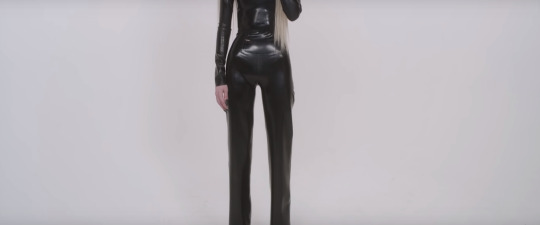
Also: Section 1 was a very steady shot, probably filmed using a tripod, or whatever fancy word camera-people use. However, the shot for Section 2 is shaky. Like, weirdly shaky. Maybe even too shaky. And this isn’t the only section filmed this way, half of “Me Laughing” is too. “Well, maybe Titanic can’t hold a camera steady.” No, that doesn’t seem right. We know Titanic can, in fact, hold a camera steady, or, at the very least, he possesses the means to take a steady shot. See: literally all Poppy videos. No, the shaky-cam is intentional. Again, I’m just here to ask: why?
Now, I don’t mean to tip my hand too much here, but to me, the camera’s sway resembles the unsteady gaze of a curious observer. Perhaps one who is timidly stepping around the beheld, drinking in all the angles. Recall my post on “Touch Poppy.” With steady camera shots, it’s easy to forget someone is on the other side, but with unsteady shots, it’s downright impossible to ignore, e.g., “wow, that shaky-cam is really noticeable. What is this, a shitty sequel to the Blair Witch Project?” Perhaps these sections were filmed this way to emphasize the presence of an observer. As for why such a thing would be emphasized—well, we’ll get to that.
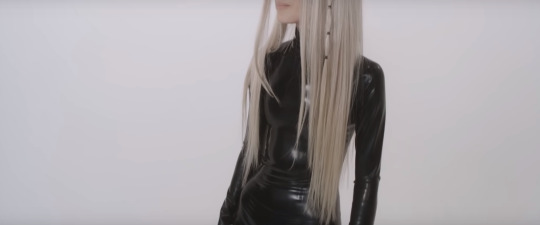
Around the 3:30 mark, Poppy shakes her head and clearly utters a, “m-mm,” as in, “nuh-uh, no way.” This gesture is repeated throughout the video. I’ll let you think about that one.

The video continues, and at 3:52 the camera lazily pans down, focusing on Poppy’s body and cutting her head out of the shot for several seconds, similar to the transition shot from Section 1 to 2. Thirty seconds later, the same thing happens. Guess this isn’t just Titanic diversifying the shot composition. It’s also about this point where attempts to pass “Me Laughing” off as anything resembling a ‘normal’ video start to fall apart.
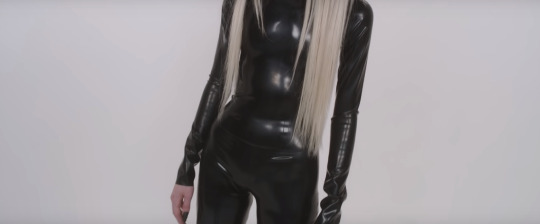
Poppy’s sitting position in Section 3 is both clever and hilarious. It shows her whole get-up, highlighting how absurdly tall her platform shoes are. She also flip-flops her feet back and forth several times as if to further emphasize her mega-shoes. Why would she wear such crazy shoes for a simple video of herself laughing?

That’s not all that’s ‘off’ about Section 3—this is also the first section where Poppy stares at a spot in the distance for a prolonged period of time. In several instances, she quizzically tilts her head to the side, not unlike a faithful dog trying to decipher commands from her master. At 6:23 we also get a clear “huh,” a noise of acknowledgement, of understanding. Further, Section 3 has several stretches of silence where Poppy is no longer laughing. She just sits there while you watch. It’s… unsettling.
Section 4 is shot in a similarly shaky-style to Section 2, but this time with Poppy sitting down. Also, we see instances of Poppy focusing on something off in the distance both when she is laughing and when she is not, as was the case in the previous sections. However, there are some weird things about Section 4 that set it apart from the others and further develop the video.
Around the 8:38 mark, Poppy utters a “mm-mm-mm” sound while shaking her head and staring off into the distance. It’s fairly clear that she is communicating with something off-screen. Perhaps entities that are invisible to us. It wouldn’t be a stretch to say these off-screen entities are the things making her laugh.
We will see more evidence of Poppy supposedly communicating with invisible beings later, however, this is bordering on fetishizing Poppy’s lore as opposed to analyzing her artistic message. If you’re half-learned on Poppy lore (which, you better be, considering the fact that you’re reading this), this would be like focusing on the identity of ‘They’ instead of the significance of ‘They.’ Another example would be focusing on the ‘origin’ of Poppy, e.g., is she an android? Who is her creator? Etc., instead of asking why someone would create the artistic work of Poppy in the first place and/or considering the implications of said work.
If you’ve read anything else I’ve written, perhaps you’ve noticed that I try and stay away from acknowledging that Poppy even has lore. I want to take Poppy seriously, not literally. Or, in “pretentious asshole” terms, to consider her work artistically, not canonically. There are many reasons for this and I didn’t just get here randomly overnight, but that’s for another post.
Edgy ranting aside, there’s another part of Section 4 that I’d like to point out. Before this section, there was only a single instance of Poppy looking into the camera (happened in Section 2), but in Section 4, she frequently looks into the lens, acknowledging that an observer is present. She shoots this observer a flurry of dark and mischievous glances. Then she laughs.
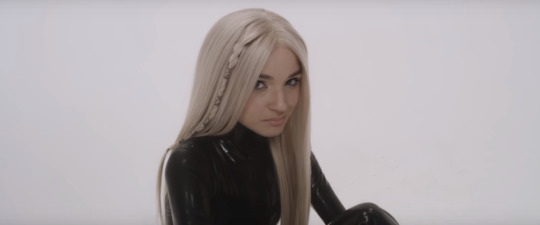
Section 5 features more head shaking, distant staring, etc., but it is also a relatively sad section. Poppy laughs very little, and frequently looks down. Yes, a pun. Poppy has been laughing for most of the video, so why, all of a sudden, does she seem so sad?
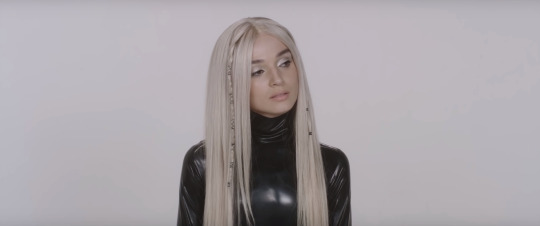
Section 6 is shot shakily and close-up. I mean, really close-up. Like, right-in-her-face close-up. To the point where the camera is often out of focus. We’re also given a blatantly voyeuristic sweep over Poppy’s chest as the camera shifts position around her. Further, there are several instances where Poppy looks deep into the camera, with what I refer to as a “model pout,” where she slightly parts her lips and opens her eyes wide. Recall my post on “Computer Boy” where I talked about the fan-idol relationship. That lustful look? It’s for you, except everybody knows it’s not.

Quick note: I will elaborate on this when I talk about “You’re Too Close,” but it’s important to stay mindful and know that despite some uncomfortably voyeuristic shots in “Me Laughing,” it doesn’t necessarily mean that the video, or anyone who worked on it, is, y’know, perverted or something. Depicting the voyeuristic nature of idolism is how we talk about the voyeuristic nature of idolism, the same way that depicting racism is how we talk about racism.
The problem is that nowadays, we are trained to think quickly, not critically. Your initial response (also called your ‘knee-jerk’ response) to Poppy’s work shouldn’t be your final response to it. It’s important to consider context and think carefully. Ask yourself: why would Poppy choose to show you this? What does she want you to think about? What is she trying to tell you?
Section 7 is where things start to get really fucking weird.
Previously, I said that there was something darker lurking in “Me Laughing,” and Section 7 is where this darkness begins to manifest. The segment starts with Poppy having another one of her imaginary conversations with demons or whatever where she nods her head and gives some “mm-hmms” in agreement. Shortly after, she looks right at the camera and laughs in your face. Not only is her laugh absolutely maniacal, but it seems completely sincere too. This section really relates the feeling that you are not in on the ‘joke’—maybe the joke’s about you.

Section 7 also provides a sense of violent foreboding: a creeping feeling that something is going to happen to you, but you don’t know what that ‘something’ is, and you have absolutely no power to stop it. What really drives this sense of helplessness home is the way the scene is shot. At one point, the camera spends a few seconds just looking at Poppy’s hand. This emphasizes your lack of control. You are completely at the mercy of the camera’s whims. You only see what is shown to you. Then, as the scene closes, the camera is put down in front of Poppy, and, after a few tense seconds, she slowly reorients her body and starts crawling towards you. Luckily, the camera is picked up before she reaches it—you were saved, but what if you hadn’t been?

Oh, right, I forgot to mention: Poppy didn’t laugh much in this section.
Section 8 is a more amped-up version of Section 6. We get Poppy staring deep into the camera for almost the entire scene’s duration. Her lustful gaze relates a feeling of vulnerability, like you are spying on a defenseless little girl, but at the same time, it feels like she is giving you one last dose of what you want before she brutally murders you.

Section 9 is fairly straightforward. We have Poppy staring at a fixed point in the distance as if she is receiving orders from her alien overlord. We also get several rapid glances toward the camera, as if her orders somehow involve you, or as if she and someone else are sharing gossip about you right in front of your face.
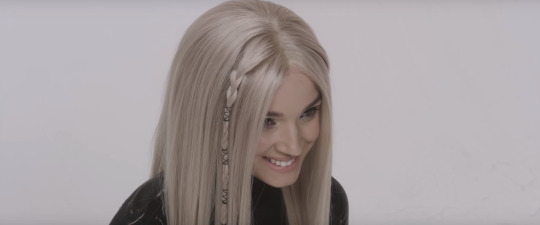
…
…
…And then Section 10 happens.
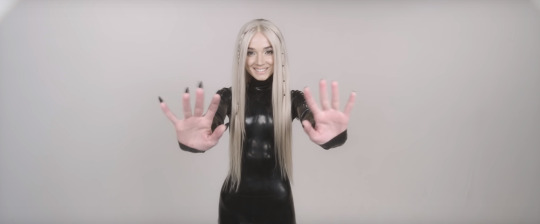
Poppy says: “goodbye.”
In Section 10 we have a bit of a climax. No, not that kind of climax. Well, unless this essay is really doing it for you.
The first interpretation of Section 10 is fairly basic, Poppy is waving goodbye because you’re about to die. Obviously, whatever scheme she and her invisible monster friends cooked up is going to be carried out, and it’s probably going to result in the destruction of everything, yourself included. This is sad, probably, but she seems to find it highly amusing. Again, I’m not a fan of obsessing over canon or lore, so I’ll tackle this one slightly differently in the analysis, but I do think this reading of “Me Laughing” is at least semi-faithful to Poppy and Titanic’s vision. This interpretation also serves as a very nice teaser for P3. I mean, if “Do you disagree?” has told us anything, P3 will have a lot of destroying.
The next reading of Section 10 involves the objectifying nature of idolism. Yes, the $5 words are starting to come out, brace yourself. Anyway, in this section, Poppy giggles as she waggles her hands around, back and forth then forth and back, as though she is using her hands for the first time. Almost like a shiny, new automaton discovering its motor functions. It’s cute, but silly. And by silly, I mean overly silly. You have to remember that Poppy is played by a woman in her mid-20s. Reminds me of some lines from “Hard Feelings”: “my arms and my legs are so stiff / Is that the way you wanted it?” Or, rather, is this how you want her to act?
At the end of the section, the camera moves right up to Poppy’s face and she looks at you and just… stares.
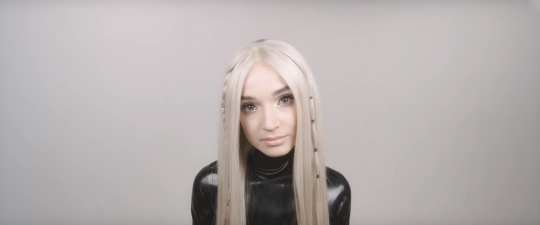
…
…
…
And stares…
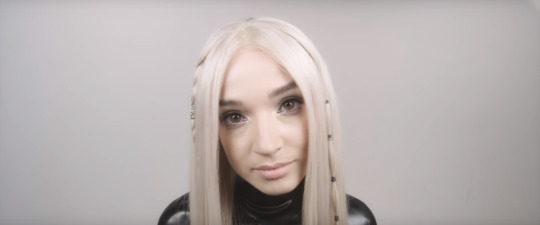
…
…
…
And stares…

…
…
…
She knows.
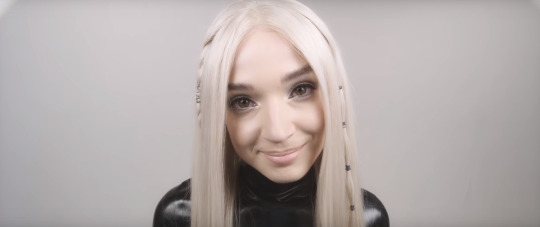
Finally, we get to Section 11, which would be my main argument against the totally boring ‘Poppy communicating with demons’ reading. Poppy is seated, again, with her arms wrapped around her thighs. Note again the sense of her smallness and vulnerability transmitted by her sitting position. Also note the way the shot is filmed, with the camera looking down on Poppy and frequently swooping in for close passes.
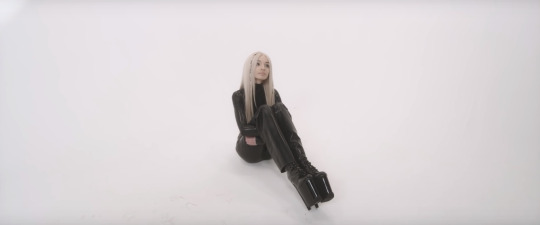
And then, in the last two seconds, something really bizarre happens. For a brief moment, some foreign object enters the shot, just in the very corner. Now, I’m about to make a weird argument, be wary of it. Other than the random piece of equipment entering the shot, “Me Laughing” does not end off on a noteworthy moment. Just Poppy sitting there, looking up at the camera. Plenty of instances of that. The video could have easily been trimmed by 2 seconds and nothing would have changed. We can also (probably) assume that somebody carefully reviewed this video before it was uploaded.
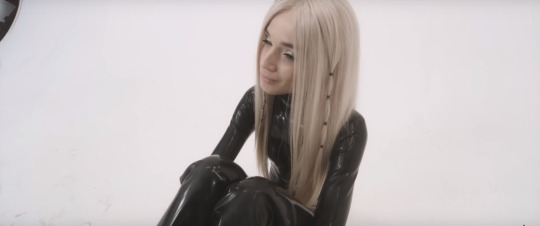
We’re left the possibility that those last two seconds were left in the video for a reason. And that reason is—
Hey, wait a minute, was that a mirror?
Analysis
“Me Laughing” is a really interesting video, and you can have a lot of fun if you spend some time looking into it, so that’s exactly what we’re going to do. We’ll tackle it from several different angles, watch for the switches.
Quick words of warning here: I’m about to use the words ‘parody,’ ‘satire,’ and ‘sarcasm’ interchangeably, a practice some would refer to as: “really fucking lazy.” Frankly, I don’t give a damn, I’m not a professional, I’m going to type my silly words anyway and you can’t stop me.
As content loses any sense of shame in attempting to draw your attention, nuance withers away and it becomes harder and harder to differentiate parody from parodied. For example, is “Old Town Road” criticizing the state of the music industry or embracing it? Now, I’m positive that Lil Nas X has the self-awareness of my pug when he’s lapping up his own boogers, yet I personally couldn’t write a song that so perfectly encapsulates everything wrong with modern music. So, is “Old Town Road” a parody or not?
This is where someone ripping off Westworld would say: “if you can’t tell, does it matter?” to which I would answer: “yes, yes it does.”
Context may be fleeting, unreliable, and arguably nonexistent, but I still believe it’s possible to differentiate parody from parodied, it just takes a little more effort. See, I think “Me Laughing” is satirical as hell, especially considering its context within Poppy’s body of work and how it compares to mainstream internet content.
First, consider that the frankly-titled video “Me Laughing” was hyped up for three days before it ‘premiered’ on YouTube. Hilarious, but also incisive. Who waits three days to see someone laugh? “Well, I did.” Ah.
The sarcastic nature of the video also shines through in the description, which reads: “A motion picture starring Poppy.” There’s a tired, yet necessary, statement here on the continuing degradation of internet content. What won’t people eat up?
We all know Poppy’s no stranger to sarcasm. See: “Bleach Blonde Baby” or “Poppy loves Politics.” She will often refer to her videos as “high quality internet content,” while uploading videos of herself eating cotton candy or ‘ooo-ing’ at things. With “Me Laughing,” a video where she laughs for 27 minutes, Poppy further questions where the line is regarding what content people will happily consume.

Fun story: I’ve seen people call “Me Laughing” ASMR. In fact, I think I did, at some point. Huh, I should probably change that. This isn’t totally wrong, but know that “Me Laughing” takes so many shots at ASMR you’d think the video shared a set with Sicario. And, if that’s the case, they could have saved some money and just filmed the video in my neighborhood haha… hah… ha… (seriously though I’m in danger)
Considering “Me Laughing” as a genuine ASMR video would obviously be antithetical to Poppy’s entire body of work. Recall lyrics like: “Poppy is an object.” No, “Me Laughing” is much more than simply Poppy recording cute ASMR.
Poppy has been questioning the nature of people’s ASMR obsession since her first YouTube video, “Poppy Eats Cotton Candy,” where she had the mic uncomfortably close to her throat so her little gulps and coos were clearly audible. What leads to people wanting to hear these things?
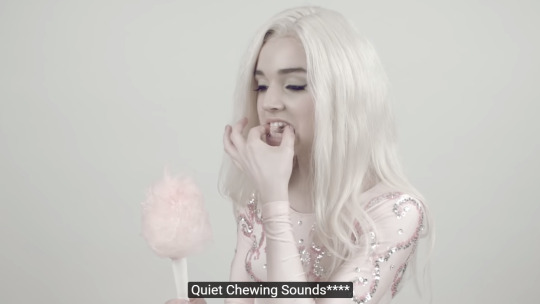
Zoom out: many of Poppy’s videos are about obsession. Forget that and the point will fly right over your head. Let’s now reframe the question: why would people want to hear such intimate sounds from Poppy? Answer that and “Me Laughing” will make a lot more sense.
What I’m about to say next will be very dense because it will outline the thesis of a large part of Poppy’s work. Sorry, hopefully it’s still readable. I’m still developing my interpretations of her work, and I promise to expand and explain them more in the future.
I’m also sure some fans will want to stab me in the neck with a rusty spoon for this post because it’ll appear like I am directly criticizing them. In reality, I am actually insinuating that Poppy is criticizing them, but nuance is dead, knee-jerk reactions reign supreme. Whatever. If you react that way, it means you’re so eyeballs deep in obsession that you fail to realize why Poppy courts your obsession in the first place. Poppy’s work entices fans to obsess over her, but it also berates those who do so.
Note that this is all as a means of criticizing the status-quo. And guess what: fans are part of the status-quo. It stings when you realize your idol’s criticisms are actually about you, but I’m not convinced Poppy is malicious. She wants you to be a better person.
This is my best estimate of her thesis: the nature of the objectification of celebrities is rooted in a sexual obsession—that is, a desire for their bodies. Pun intended. Objectification stems from fantasizing over what the celebrity shows you, which is almost always physical, or at least results in the fantasy manifesting itself as a physical representation.
In other words: “everybody wants to be Poppy.”
Poppy recognizes the inherently sexual obsession with figures in the ASMR community. She wears latex in “Me Laughing” to draw attention to this. It’s as if she was saying: “this is what you’re here for, right?”
Note that obsession is inherently progressive. It grows and grows, eventually leading to fans voyeuristically observing the objectified person’s intimate bodily functions. This culminates in “Me Laughing.” Poppy knows what you want, but as payment, she’s going to leave a nagging feeling in your brain that somehow you have done something wrong. That you shouldn’t really be watching this video, but she knows you are.
Recall Titanic’s comments about making people slightly uncomfortable. Consuming is harder with a lump in your throat. The key to understanding Poppy’s work is to ask why she wants you to feel uncomfortable. What about your behavior does she want you to realize?
Earlier in the post, I mentioned that I’m not a huge fan of the whole ‘Poppy talking to demons about destroying the world’ reading because it comes dangerously close to obsessing over her lore. Lore is like history without the usefulness, so I’m going to ignore it. Regardless, I said I would use that interpretation for something more interesting, so I’d like to ask:
What makes someone want to destroy the world?
Throughout “Me Laughing,” Poppy shoots dark glares at the camera. There’s something sinister in her eyes, something genuinely evil lurking in her gaze. We know she obviously has an immense disdain for the status-quo. What else would lead to lyrics like: “down, let it all burn down / burn it to the ground”?

Preceding any cries of “viva la revolución!” or “apocalypse, now!” is an implicit judgement that what is left of the world is either not able to be saved, or not worth saving. That tearing everything down and beginning anew is preferable to salvaging what remains. To reach such a mindset, one would need to see modern society with such disgust and be so disenchanted with our current world that it no longer appears worth preserving. One would also need to have given up hope on the ability for people to come together and solve their problems. To have lost hope in humanity’s ability to adapt and overcome. To think that perhaps our problems have become too big for us to solve, that perhaps we have finally dug too deep a hole to climb out of.
Again, people don’t reach a hopeless mindset overnight; it takes many steps to descend into the darkness. But, the numpties on r/GetMotivated tell me, “every journey begins with a single step,” so let’s take one together.
In a tweet, I mentioned that “Me Laughing” was also about absurdism. No, that wasn’t a typo for ‘absurdity.’ I may write ridiculously deep-dives into Poppy lyrics and lore, but I try not to waste words.
Anyway, let’s play a game. I call it the “imagine something real quick because I need to prove a point” game.
Imagine being stuck in a system. Yes, it’s cliché to use the word ‘system,’ and any time you do, it carries the connotation that you are some conspiracy nut, e.g., “you can’t trust the system man!” I understand all this, please just bear with me and let me use the word, it’s useful. Anyway, you don’t like the system because a lot of the system is bad and it’s slowly, but surely, getting worse. The cracks are starting to show and the whole thing is poised to come crumbling down. Okay, that’s not good, you want to tell people about this. To warn them. However, in order to obtain a sizable audience for your message, you need to first succeed within the system, and to do that, you need to play by the system’s rules.
Okay, no sweat, you release some pop songs. There’s a couple of them that people really dig. Unfortunately, the songs people like don’t contain much of your message. They have a watered-down version of it at best. That’s a little sad, but oh well, at least you’re getting some sort of message out there. Hey, maybe if you make the music video really weird, people will realize there’s something more going on! Hm, that didn’t seem to work either.
So you release some YouTube videos too. Some of them are pretty biting, especially that one on politics. Should get people thinking, right? Hah, no, wrong. People like them, yes, but not for the reasons you want. They like them because they’re “weird” and “addictive” e.g., “its 3 AM on a school night and I’m still watching Poppy videos why can’t I stop lolol.” Imagining that the videos contain some sort of Illuminati-esque hidden message to decode is preferable to examining the real-world implications of the work. Plus, like, there’s experts for that, right?
Anyway, a couple albums and hundreds of videos later, you have a sizable following, sweet, now you can transition to doing what you’ve always wanted to. Change the persona to something a little truer to yourself. Make your message a little clearer. Finally, you have the power to change the world like you always promised you would.
Uh-oh, Houston, we’ve got a problem. Your audience listened to you for X, but now you’re giving them Y. It’s not a total loss, though. You have a lot of loyal members in your audience, and they like your new stuff too. Doesn’t matter what you make, they’re loyal, they’ll watch/listen/whatever to it. Their dedication has become investment which has become even more dedication. In fact, they’ve been following you since the start, when you were first trying to get big. “Yes, but I was trying to get big because I wanted to spread a message and to do that I had to make compromises to grow an audience so people would liste—“
They also have their own ideas of what you’re saying, plus, like, they make neat art, here, check this out, please give this a listen, look at this, read this, please, please? “Hey, nice article. Wait, the next one is how many words?!” And you keep every piece of fan art because it really does mean a lot to you. “Wow, I appreciate it, that’s beautiful, thank you. Oh, what? There’s even more?” Hey, if you have spare minute, could you give a shout-out to my friend? It’s her birthday. “Sure, hold on…” It’s also my birthday tomorrow, could you give this post a like? “Um, okay, just give me a minut—“ Also, could you answer my DM on Instagram? It’s important. And after that there’s only 100 more to answer! kk thanks! “Wait… one second… whoa!”
Now you’re releasing Z, hopefully that will get your message across…
…
…
…
Wait—what was your message again?
…
…
…
Oh no.
…
…
…
Somewhere along the way, probably between performing [this] and signing [that], the essence of your message was lost. Whatever remains has been drowned out by the noise of the system. If we’re talking decibels, notifications are loud, problems are whispers, and these days everyone’s got ear plugs.
Thinking about problems is hard, thinking about them for too long is sad, being sad is uncomfortable, hey, look, Taylor Swift just dropped a new album, that “Lover” song is dope, let’s look at memes.
So, you want to change the system. But to change the system you need power. To get power, you need an audience. But the only way to get an audience is to make content that gets rewarded by the system. And the content that gets rewarded by the system is that which is easily digestible for a large audience, i.e., devoid of substance. I mean, I don’t know about you, but I don’t think “Turn Down for What” resulted in much positive social change. “Well, maybe the system should reward content that is creative, challenging, and conscientious instead!” Ah, yes, I see what you mean. So, you want to change the system…
Pass the mic, Camus, I’ve got a real knee-slapper for ya. Oh, right, guess I’ll just grab it myself.
These days, we’re faced with a new kind of absurdism, one which involves recognizing that societal systems are getting worse and need changing, while simultaneously recognizing that you are chained by said systems, and thus, powerless to change them.
This new absurdism describes the maddening exercise in doublethink where people wrestle with the knowledge that they should be Making The World A Better Place but also the knowledge that they cannot possibly live in a way that satisfies such capitalized phrases. The end result is a mental tearing fueled by impossible societal expectations and the inevitable guilt of failing to live up to them.
After a while, people stop fighting. They give up. They give in. When enough people throw in the towel, all that’s left is to hold on tight and enjoy the ride, e.g., the trajectory is set, all aboard, no, there aren’t enough seat belts for everyone, must have been one of those damn cost-saving initiatives.
“Yeah, that definitely sounds absurd. So… what do we do about it?”
Well, sometimes all you can do is laugh.
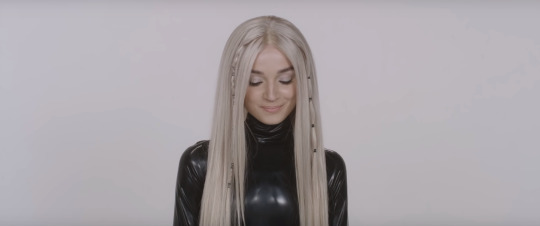
8 notes
·
View notes
Note
hi, hope you're doing well! for the recent ask blog: rant about something!! any thing you want!
yoooo long time no talk!! unfortunately, i’m a better listener than a talker/ranter, lol.
i guess i can talk about this one guy i had to do a group project with? to set up the scene, we are both in an upper division nutrition class only offered to seniors in our major. we had to read and present a scientific research paper to the class in a group presentation. the first time we met as a group, i asked for a reminder of what the difference between the results and conclusion sections are in a paper, and he answered, then went on to tell me HOW TO READ A FKING RESEARCH PAPER. we’re all seniors, in the same major, and he just assumed i didn’t know how to read a paper. he was like, this paper is pretty heavy, so if you get lost and lose track of what it’s talking about, just look back at the abstract. once i realized i was being mansplained to, i was very not unsubtly giving him the side-eye, lol. he didn’t notice. he also called himself a great public speaker and claimed the intro and discussion sections of the presentation for himself. (during the actual presentation, he made up some info for the intro and led a discussion instead of doing what he was supposed to and giving his own opinions on how the information from this paper can be applied practically.)
after he left i found out from the other girl in our group that he hadn’t even read the actual paper yet. later i realized that he must have just assumed i wouldn’t understand the paper. the fking nerve of this guy.
he’s white and conventionally attractive. i wonder if he just looked at me and assumed i’m an international student? because i’m chinese? this was actually the first sexist/racist encounter i’ve had happen to me, other than this one time where a hispanic? car dealer at a car dealership just said “ni hao” out of nowhere at my family. (which was so baffling to me?? like, are you trying to show us that you know a basic phrase that p much everyone knows??)
2 notes
·
View notes
Text
Final Reflection 12/19/2019
My Creative Process
The hardest part about filmmaking is liking what you create, at least for me. Earlier, my friend Maggie asked how I felt about the project now that it was finished, and I told her what my colleagues and my friends had thought about it, which was overall a positive outlook on the film. That was the easiest way for me to explain it, through the eyes of others. I certainly feel good about my film, but it’s always hard to say with certainty if I like it or not.
What I definitely feel satisfied with and proud of is the amount of work that I put in it. I started this project trying to model an example of a social impact film. I wanted to make a film that had the potential of impacting the Kenyon community in some way, and that is what I went with. I knew I didn’t want to do something comedic or something historical not because I don’t value those things, but because I want to do social impact film and media in the future. I took this opportunity to train myself, and I genuinely learned skills that will help me fulfill that goal in the future.
The most important lesson was to feel comfortable preparing and performing interviews. Talking to people when you have a camera in front of them is much harder than just talking to them. You have to first make them feel comfortable with the situation, and that takes some preparation. I tried to have some easy questions at the beginning of every interview, so that I could just chat with my subjects and make them forget about the camera, but in some cases this didn’t work, or it took more time than what I expected. In the case of Erin Salva specifically, who I ended up not editing into my documentary, she asked me to do the interview a second time, and when we did, she seemed much more comfortable than before.
It was also hard for me to tackle a topic that I didn’t have any sort of experiential information for. You can read and listen to many people talk about physical accessibility and physical disability, but I will never be able to talk about an experience in the same way that a person who has personal experience. Thus, many times I was very scared to offend someone, but eventually I learned that people who have agreed to an interview are more willing to talk to me and help me understand than I initially believed. I also decided I wouldn’t worry about mistakes, and just apologize if I say something wrong. People are bound to make mistakes, and I think that’s ok. My subjects were very pleased with the interviews by the time they were all finished, so I think I handled them pretty well. They were all excited to see the final project.
B-roll was also really hard to conceptualise throughout the course of this project. I didn’t want to just illustrate what my subjects were saying. I remember telling Matt and Zack, my main cinematographers, that I wanted to capture B-roll that I could use in evocative or expressful ways. I think the final sequence of the final cut illustrates what I mean by that, as well as the sequence where the camera is racking focus on the map, and below it we have a shot of people walking through Middle Path. In general, it was just hard for me to find creative ways to shoot this space, Middle Path, in a way that felt different and unique. It’s a space that so often photographed, and so simple in its basic components, that I couldn’t think of many instances to shake things off. That’s why I relied so heavily on the bronze map and the Gates of Hell. They were visually much more interesting than the rest of the map, which was just gravel.
And yes, many times I wanted to shoot Middle Path during a rainy day or during a really cold, snowy or frozen day, but those days happened at times in which I didn’t have equipment. I also was not sure how to shoot during a rainy day and, not wanting to hurt the equipment, I decided to go with what I had. This was obviously a mistake. This footage would have helped me so much in my story, as it illustrates exactly what happens to Middle Path at its worst time. If I could go back and re-do anything, it would be this.
Editing was a grind at first. I wasn’t sure how to cut down the interviews. I tried many different things, but I ended up deciding for a system at the end. I would color code, instead of just cutting and deleting chunks of footage, in such a way that I would be able to identify which clips were really good, which were relevant, which were ok, and which were just unnecessary. Cyan, violet, yellow and red, respectively. I ended up adding an extra color (“mango”), to refer to lines my subjects said that were extremely relevant to the story I was constructing, but down the line it just became another color I was using for “really good”. Next time I make a documentary, I need to find a better system. I would appreciate any resources where I could read about how to cut interviews down!
After that, I just had to re-organize information in a compelling way for my argument, and then match what people said with the B-roll I had collected. This was also hard, but not nearly as much as deciding what parts of the interviews to choose. It came more natural for me. I don’t have many comments for this part. Music helped a lot in some cases. The intro and the conclusion wouldn’t have felt the same without the music, I believe.
My Collaborators
I had the amazing opportunity to work with many of my peers in different areas of my film, but I believe the 2 most important ones were cinematography and interview preparation. In terms of cinematography, Matt Harrington and Zack Richeimer were the two people behind most of the B-roll (Matt also shot two of the interviews). They helped me conceptualise different creative ideas for B-roll. Before each time we went out to shoot, I would have a general plan that they would expand through improvisation once we were out in the field. The most memorable experience that I have is shooting B-roll at the construction site. It was fun, a little scary, and also full of images that I wouldn’t stumble upon on a daily basis. I didn’t use as much of that footage as I would have liked, for story reasons, but I have to thank Zack for the quality of the images produced at that time. Zack also helped me with B-roll of Middle Path, which was the hardest for me to conceptualise. In the end, we decided to have many different shots of the bronze map and the Gates of Hell, which ended up being central visual pieces to the film.
Matt shot most of the B-roll of campus. It was easy working with him because he knows me well, and we managed to get vast amounts of B-roll in little time. He also indulged me in some of the more abstract ideas that I had, like the slow motion shot of the rocks falling from my hands. Most of the B-roll in this documentary was shot by him, and I don’t think I would have been able to have nearly as much footage without him.
In terms of interview preparation, I have to thank Alasia Destine-DeFreece, and Olivia Kane. Not only did they help me with the interview questions, which I was having trouble phrasing, but also with the emails that I sent to my interview subjects in order to establish contact with them and ask them to be part of my project. Alasia also helped me come up with new additions to my questions, which ended up being a vital part to my interviews.
0 notes
Text
A Beginner’s Guide to Reading Scientific Research
Scientific journal articles can be incredibly intimidating to read, even for other scientists. Heck, I have a Ph.D. in a research science and have authored scientific papers, but sometimes I look at a research report outside my field of study and just go, “Nope, can’t decipher this.”
Learning to read them is an important skill, however, in today’s environment of what I call “research sensationalism.” This is where the popular media gets hold of a scientific research report and blows the findings WAY out of proportion, usually while misrepresenting what the researchers actually did and/or found. You know what I’m talking about.
Unfortunately, you can’t trust popular media reports about scientific research studies. Too often, it’s shockingly evident that the people writing these reports (a) aren’t trained to evaluate scientific research, and (b) are just parroting whatever newswire release they got that morning with no apparent fact-checking.
Thus, if staying informed is important to you—or you just want to be able to shut down all the fearmongers in your life—you need to learn how to read the original journal articles and form your own judgments. You don’t have to become an expert in every scientific field, nor a statistician, to do so. With a little know-how, you can at least decide if the popular media reports seem accurate and if any given study is worth your time and energy.
Where to Begin
First things first, locate the paper. If it’s behind a paywall, try searching Google Scholar to see if you can find it somewhere else. Sometimes authors upload pdfs to their personal webpages, for example.
Ten years ago, I would have told you to check the journal’s reputation next. Now there are so many different journals with different publishing standards popping up all the time, it’s hard to keep up. More and more researchers are choosing to publish in newer open access journals for various reasons.
Ideally, though, you want to see that the paper was peer reviewed. This means that it at least passed the hurdle of other academics agreeing that it was worth publishing. This is not a guarantee of quality, however, as any academic can tell you. If a paper isn’t peer reviewed, that’s not an automatic dismissal, but it’s worth noting.
Next, decide what type of paper you’re dealing with:
Theoretical papers
Authors synthesize what is “known” and offer their own interpretations and suggestions for future directions.
Rarely the ones getting popular press.
Great if you want to know the new frontiers and topics of debates in a given field.
Original research, aka empirical research
Report the findings of one of more studies where the researchers gather data, analyze it, and present their findings.
Encompasses a wide variety of methods, including ethnographic and historical data, observational research, and laboratory-based studies.
Meta-analyses & systematic reviews
Attempt to pool or summarize the findings of a group of studies on the same topic to understand the big picture.
Combining smaller studies increases the number of people studied and the statistical power. It can also “wash out” minor problems in individual studies.
Only as good as the studies going into them. If there are too few studies, or existing studies are of poor quality, pooling them does little. Usually these types of reports include a section describing the quality of the data.
Since popular media articles usually focus on empirical research papers, that’s what I’ll focus on today. Meta-analyses and reviews tend to be structured in the same way, so this applies to them as well.
Evaluating Empirical Research
Scientists understand that even the best designed studies will have issues. It’s easy to pick apart and criticize any study, but “issues” don’t make studies unreliable. As a smart reader, part of your job is to learn to recognize the flaws in a study, not to tear it down necessarily, but to put the findings in context.
For example, there is always a trade-off between real-world validity and experimental control. When a study is conducted in a laboratory—whether on humans, mice, or individual cells—the researchers try to control (hold constant) as many variables as possible except the ones in which they are interested. The more they control the environment, the more confident they can be in their findings… and the more artificial the conditions.
That’s not a bad thing. Well-controlled studies, called randomized control trials, are the best method we have of establishing causality. Ideally, though, they’d be interpreted alongside other studies, such as observational studies that detect the same phenomenon out in the world and other experiments that replicate the findings.
NO STUDY IS EVER MEANT TO STAND ON ITS OWN. If you take nothing else from this post, remember that. There is no perfect study. No matter how compelling the results, a single study can never be “conclusive,” nor should it be used to guide policy or even your behavioral choices. Studies are meant to build on one another and to contribute to a larger body of knowledge that as a whole leads us to better understand a phenomenon.
Reading a Scientific Journal Article
Most journal articles follow the same format: Abstract, Introduction, Methods, Results, Discussion/Conclusions. Let’s go through what you should get out of each section, even if you’re not a trained research scientist.
The Abstract succinctly describes the purpose, methods, and main findings of the paper. Sometimes you’ll see advice to skip the abstract. I disagree. The abstract can give you a basic idea of whether the paper is interesting to you and if it is likely to be (in)comprehensible.
DO NOT take the abstract at face value though. Too often the abstract oversimplifies or even blatantly misrepresents the findings. The biggest mistake you can make is reading only the abstract. It is better to skip it altogether than to read it alone.
The Introduction describes the current research question, i.e., the purpose of the study. The authors review past literature and set up why their study is interesting and needed. It’s okay to skim the intro.
While reading the introduction:
Make a note of important terms and definitions.
Try to summarize in your own words what general question the authors are trying to address. If you can, also identify the specific hypothesis they are testing. For example, the question might be how embarrassment affects people’s behavior in social interactions, and the specific hypothesis might be that people are more likely to insult people online when they feel embarrassed.
You might choose to look up other studies cited in the introduction.
The Methods should describe exactly what the researchers did in enough detail that another researcher could replicate it. Methods can be dense, but I think this is the most important section in terms of figuring out how much stock you should be putting in the findings.
While reading the methods, figure out:
Who/what were the subjects in this study? Animals, humans, cells?
If this is a human study, how were people selected to participate? What are their demographics? How well does the sample represent the general population or the population of interest?
What type of study is this?
Observational: observing their subjects, usually in the natural environment
Questionnaire/survey: asking the subject questions such as opinion surveys, behavioral recall (e.g., how well they slept, what they ate), and standardized questionnaires (e.g., personality tests)
Experimental: researchers manipulate one or more variables and measure the effects
If this is an experiment, is there a control condition—a no-treatment condition used as a baseline for comparison?
How were the variables operationalized and measured? For example, if the study is designed to compare low-carb and high-carb diets, how did the researchers define “low” and “high?” How did they figure out what people were eating?
Some red flags that should give you pause about the reliability of the findings are:
Small or unrepresentative sample (although “small” can be relative).
Lack of a control condition in experimental designs.
Variables operationalized in a way that doesn’t make sense, for example “low-carb” diets that include 150+ grams of carbs per day.
Variables measured questionably, as with the Food Frequency Questionnaire.
The Results present the statistical analyses. This is unsurprisingly the most intimidating section for a lot of people. You don’t need to understand statistics to get a sense of the data, however.
While reading the results:
Start by looking at any tables and figures. Try to form your own impression of the findings.
If you aren’t familiar with statistical tests, do your best to read what they authors say about the data, paying attention to which effects they are highlighting. Refer back to the tables and figures and see if what they’re saying jibes with what you see.
Pay attention to the real magnitude of any differences. Just because two groups are statistically different or something changes after an intervention doesn’t make it important. See if you can figure out in concrete terms how much the groups differed, for example. If data are only reported in percentages or relative risk, be wary of drawing firm conclusions.
It can take a fair amount of effort to decipher a results section. Sometimes you have to download supplementary data files to get the raw numbers you’re looking for.
The Discussion or Conclusions summarize what the study was about. The authors offer their interpretation of the data, going into detail about what they think the results actually mean. They should also discuss the limitations of the study.
While reading the discussion:
Use your own judgment to decide if you think the authors are accurately characterizing their findings. Do you agree with their interpretation? Are they forthcoming about the limitations of their study?
Red flags:
Concrete statements like “proved.” Hypotheses can be supported, not proven.
Talking in causal terms when the data is correlational! As I said above, well-controlled experimental designs are the only types of research that can possibly speak to causal effects. Questionnaire, survey, and historical data can tell you when variables are potentially related, but they say nothing about what causes what. Anytime authors use words like “caused,” “led to,” or “_[X]_ increased/decreased _[Y]_” about variables they didn’t manipulate in their study, they are either being sloppy or intentionally misleading.
What about Bias?
Bias is tricky. Even the best intentioned scientists can fall victim to bias at all stages of the research process. You certainly want to know who funded the study and if the researchers have any conflicts of interest. That doesn’t you should flatly dismiss every study that could potentially be biased, but it’s important to note and keep in mind. Journal papers should list conflicts of interest.
Solicit Other Opinions
Once you feel like you have your own opinion about the research, see what other knowledgeable people you trust have to say. I have a handful of people I trust for opinions—Mark, of course, Chris Kresser, and Robb Wolf being a few. Besides fact-checking yourself, this is a good way to learn more about what to look for when reading original research.
To be clear, I don’t think it’s important that you read every single study the popular media grabs hold of. It’s often okay just to go to your trusted experts and see what they say. However, if a report has you really concerned, or your interest is particularly piqued, this is a good skill to have.
Remember my admonition: No study is meant to stand alone. That means don’t put too much stock in any one research paper. It also means don’t dismiss a study because it’s imperfect, narrow in scope, or you can otherwise find flaws. This is how science moves forward—slowly, one (imperfect) study at a time.
That’s it for today. Share your questions and observations below, and thanks for reading.
(function($) { $("#dfb43kq").load("https://www.marksdailyapple.com/wp-admin/admin-ajax.php?action=dfads_ajax_load_ads&groups=674&limit=1&orderby=random&order=ASC&container_id=&container_html=none&container_class=&ad_html=div&ad_class=&callback_function=&return_javascript=0&_block_id=dfb43kq" ); })( jQuery );
window.onload=function(){ga('send', { hitType: 'event', eventCategory: 'Ad Impression', eventAction: '67622' });}
The post A Beginner’s Guide to Reading Scientific Research appeared first on Mark's Daily Apple.
A Beginner’s Guide to Reading Scientific Research published first on https://venabeahan.tumblr.com
0 notes
Text
A Beginner’s Guide to Reading Scientific Research
Scientific journal articles can be incredibly intimidating to read, even for other scientists. Heck, I have a Ph.D. in a research science and have authored scientific papers, but sometimes I look at a research report outside my field of study and just go, “Nope, can’t decipher this.”
Learning to read them is an important skill, however, in today’s environment of what I call “research sensationalism.” This is where the popular media gets hold of a scientific research report and blows the findings WAY out of proportion, usually while misrepresenting what the researchers actually did and/or found. You know what I’m talking about.
Unfortunately, you can’t trust popular media reports about scientific research studies. Too often, it’s shockingly evident that the people writing these reports (a) aren’t trained to evaluate scientific research, and (b) are just parroting whatever newswire release they got that morning with no apparent fact-checking.
Thus, if staying informed is important to you—or you just want to be able to shut down all the fearmongers in your life—you need to learn how to read the original journal articles and form your own judgments. You don’t have to become an expert in every scientific field, nor a statistician, to do so. With a little know-how, you can at least decide if the popular media reports seem accurate and if any given study is worth your time and energy.
Where to Begin
First things first, locate the paper. If it’s behind a paywall, try searching Google Scholar to see if you can find it somewhere else. Sometimes authors upload pdfs to their personal webpages, for example.
Ten years ago, I would have told you to check the journal’s reputation next. Now there are so many different journals with different publishing standards popping up all the time, it’s hard to keep up. More and more researchers are choosing to publish in newer open access journals for various reasons.
Ideally, though, you want to see that the paper was peer reviewed. This means that it at least passed the hurdle of other academics agreeing that it was worth publishing. This is not a guarantee of quality, however, as any academic can tell you. If a paper isn’t peer reviewed, that’s not an automatic dismissal, but it’s worth noting.
Next, decide what type of paper you’re dealing with:
Theoretical papers
Authors synthesize what is “known” and offer their own interpretations and suggestions for future directions.
Rarely the ones getting popular press.
Great if you want to know the new frontiers and topics of debates in a given field.
Original research, aka empirical research
Report the findings of one of more studies where the researchers gather data, analyze it, and present their findings.
Encompasses a wide variety of methods, including ethnographic and historical data, observational research, and laboratory-based studies.
Meta-analyses & systematic reviews
Attempt to pool or summarize the findings of a group of studies on the same topic to understand the big picture.
Combining smaller studies increases the number of people studied and the statistical power. It can also “wash out” minor problems in individual studies.
Only as good as the studies going into them. If there are too few studies, or existing studies are of poor quality, pooling them does little. Usually these types of reports include a section describing the quality of the data.
Since popular media articles usually focus on empirical research papers, that’s what I’ll focus on today. Meta-analyses and reviews tend to be structured in the same way, so this applies to them as well.
Evaluating Empirical Research
Scientists understand that even the best designed studies will have issues. It’s easy to pick apart and criticize any study, but “issues” don’t make studies unreliable. As a smart reader, part of your job is to learn to recognize the flaws in a study, not to tear it down necessarily, but to put the findings in context.
For example, there is always a trade-off between real-world validity and experimental control. When a study is conducted in a laboratory—whether on humans, mice, or individual cells—the researchers try to control (hold constant) as many variables as possible except the ones in which they are interested. The more they control the environment, the more confident they can be in their findings… and the more artificial the conditions.
That’s not a bad thing. Well-controlled studies, called randomized control trials, are the best method we have of establishing causality. Ideally, though, they’d be interpreted alongside other studies, such as observational studies that detect the same phenomenon out in the world and other experiments that replicate the findings.
NO STUDY IS EVER MEANT TO STAND ON ITS OWN. If you take nothing else from this post, remember that. There is no perfect study. No matter how compelling the results, a single study can never be “conclusive,” nor should it be used to guide policy or even your behavioral choices. Studies are meant to build on one another and to contribute to a larger body of knowledge that as a whole leads us to better understand a phenomenon.
Reading a Scientific Journal Article
Most journal articles follow the same format: Abstract, Introduction, Methods, Results, Discussion/Conclusions. Let’s go through what you should get out of each section, even if you’re not a trained research scientist.
The Abstract succinctly describes the purpose, methods, and main findings of the paper. Sometimes you’ll see advice to skip the abstract. I disagree. The abstract can give you a basic idea of whether the paper is interesting to you and if it is likely to be (in)comprehensible.
DO NOT take the abstract at face value though. Too often the abstract oversimplifies or even blatantly misrepresents the findings. The biggest mistake you can make is reading only the abstract. It is better to skip it altogether than to read it alone.
The Introduction describes the current research question, i.e., the purpose of the study. The authors review past literature and set up why their study is interesting and needed. It’s okay to skim the intro.
While reading the introduction:
Make a note of important terms and definitions.
Try to summarize in your own words what general question the authors are trying to address. If you can, also identify the specific hypothesis they are testing. For example, the question might be how embarrassment affects people’s behavior in social interactions, and the specific hypothesis might be that people are more likely to insult people online when they feel embarrassed.
You might choose to look up other studies cited in the introduction.
The Methods should describe exactly what the researchers did in enough detail that another researcher could replicate it. Methods can be dense, but I think this is the most important section in terms of figuring out how much stock you should be putting in the findings.
While reading the methods, figure out:
Who/what were the subjects in this study? Animals, humans, cells?
If this is a human study, how were people selected to participate? What are their demographics? How well does the sample represent the general population or the population of interest?
What type of study is this?
Observational: observing their subjects, usually in the natural environment
Questionnaire/survey: asking the subject questions such as opinion surveys, behavioral recall (e.g., how well they slept, what they ate), and standardized questionnaires (e.g., personality tests)
Experimental: researchers manipulate one or more variables and measure the effects
If this is an experiment, is there a control condition—a no-treatment condition used as a baseline for comparison?
How were the variables operationalized and measured? For example, if the study is designed to compare low-carb and high-carb diets, how did the researchers define “low” and “high?” How did they figure out what people were eating?
Some red flags that should give you pause about the reliability of the findings are:
Small or unrepresentative sample (although “small” can be relative).
Lack of a control condition in experimental designs.
Variables operationalized in a way that doesn’t make sense, for example “low-carb” diets that include 150+ grams of carbs per day.
Variables measured questionably, as with the Food Frequency Questionnaire.
The Results present the statistical analyses. This is unsurprisingly the most intimidating section for a lot of people. You don’t need to understand statistics to get a sense of the data, however.
While reading the results:
Start by looking at any tables and figures. Try to form your own impression of the findings.
If you aren’t familiar with statistical tests, do your best to read what they authors say about the data, paying attention to which effects they are highlighting. Refer back to the tables and figures and see if what they’re saying jibes with what you see.
Pay attention to the real magnitude of any differences. Just because two groups are statistically different or something changes after an intervention doesn’t make it important. See if you can figure out in concrete terms how much the groups differed, for example. If data are only reported in percentages or relative risk, be wary of drawing firm conclusions.
It can take a fair amount of effort to decipher a results section. Sometimes you have to download supplementary data files to get the raw numbers you’re looking for.
The Discussion or Conclusions summarize what the study was about. The authors offer their interpretation of the data, going into detail about what they think the results actually mean. They should also discuss the limitations of the study.
While reading the discussion:
Use your own judgment to decide if you think the authors are accurately characterizing their findings. Do you agree with their interpretation? Are they forthcoming about the limitations of their study?
Red flags:
Concrete statements like “proved.” Hypotheses can be supported, not proven.
Talking in causal terms when the data is correlational! As I said above, well-controlled experimental designs are the only types of research that can possibly speak to causal effects. Questionnaire, survey, and historical data can tell you when variables are potentially related, but they say nothing about what causes what. Anytime authors use words like “caused,” “led to,” or “_[X]_ increased/decreased _[Y]_” about variables they didn’t manipulate in their study, they are either being sloppy or intentionally misleading.
What about Bias?
Bias is tricky. Even the best intentioned scientists can fall victim to bias at all stages of the research process. You certainly want to know who funded the study and if the researchers have any conflicts of interest. That doesn’t you should flatly dismiss every study that could potentially be biased, but it’s important to note and keep in mind. Journal papers should list conflicts of interest.
Solicit Other Opinions
Once you feel like you have your own opinion about the research, see what other knowledgeable people you trust have to say. I have a handful of people I trust for opinions—Mark, of course, Chris Kresser, and Robb Wolf being a few. Besides fact-checking yourself, this is a good way to learn more about what to look for when reading original research.
To be clear, I don’t think it’s important that you read every single study the popular media grabs hold of. It’s often okay just to go to your trusted experts and see what they say. However, if a report has you really concerned, or your interest is particularly piqued, this is a good skill to have.
Remember my admonition: No study is meant to stand alone. That means don’t put too much stock in any one research paper. It also means don’t dismiss a study because it’s imperfect, narrow in scope, or you can otherwise find flaws. This is how science moves forward—slowly, one (imperfect) study at a time.
That’s it for today. Share your questions and observations below, and thanks for reading.
(function($) { $("#dftpOiZ").load("https://www.marksdailyapple.com/wp-admin/admin-ajax.php?action=dfads_ajax_load_ads&groups=674&limit=1&orderby=random&order=ASC&container_id=&container_html=none&container_class=&ad_html=div&ad_class=&callback_function=&return_javascript=0&_block_id=dftpOiZ" ); })( jQuery );
window.onload=function(){ga('send', { hitType: 'event', eventCategory: 'Ad Impression', eventAction: '94540' });}
The post A Beginner’s Guide to Reading Scientific Research appeared first on Mark's Daily Apple.
A Beginner’s Guide to Reading Scientific Research published first on https://drugaddictionsrehab.tumblr.com/
0 notes
Text
A FUNDRAISING SURVIVAL GUIDE TO DIE
He showed how, given a handful of them. This caught my attention because earlier we'd noticed a pattern in the least successful startups we'd funded: they all seemed hard to talk to?1 Think about what it means. But eventually the open source world won, by producing Javascript libraries that grew over the brokenness of Explorer the way a startup feels is at least a random sample of the applicants that were selected, b their subsequent performance is measured, and in any case the odds of succeeding are higher in a startup. But there's more going on than that. It turns out there is, and the key to the mystery is the old adage a word to the wise is sufficient. For us the main indication of impending doom is when we don't hear from you. A cluttered room saps one's spirits.
Sometimes the feedback loop that makes the product good.2 The information needed to conduct such studies is increasingly available. Steve Jobs had already done it: insanely great. But it's gone now. But in retrospect it was exactly the right thing to do, because it seems sympathetic to their cause.3 Another advantage of bad times is that there's less competition. If you're in grad school, but we're going to keep working on the startup, but we're going to retrace his steps, with his mathematical notation translated into running Common Lisp code. As food got cheaper or we got richer; they're indistinguishable, eating too much started to be a bigger danger than eating too little.
I didn't mean this as an essay; I wrote it down because I only had two hours before dinner and think fastest while writing. What founders have a hard time grasping and Steve himself might have had a hard time grasping and Steve himself might have had a hard time grasping and Steve himself might have had a hard time grasping is what insanely great translates to in a larval startup. The reason I began by saying that this technique would come as a surprise to First Round that they performed one. Even if you start measuring something you start optimizing it, and I was even more convinced of it after hearing it confirmed by Hilbert. We just don't notice usually, because they didn't seem especially committed. It makes the same point: that it can't have been the personal qualities of early union organizers that made unions successful, but must have been some external factor, or otherwise present-day union leaders would shrink from the challenge. A friend of mine cured herself of a clothes buying habit by asking herself before she bought anything Am I going to wear this all the time is not because it has something to say about programming languages.4 Most good startup ideas seem at first like bad ideas.5 That has always seemed to me an important point, and I realized Steve Jobs had already done it: insanely great. I've been there, and that's as much as any startup needs initially. The probability that a startup will make it big.
But I don't write to persuade; I write to figure out. So the mere constraint of staying in regular contact with us you could get users merely by broadcasting your existence, rather than running the whole show. Likewise, the reason we hear about Java as part of a plan by Sun to undermine Microsoft. This is just an explanation of why I don't like the look of Java: It has been so energetically hyped.6 The rest of my stuff I left in my landlady's attic back in the US are also big tourist destinations: San Francisco, or Boston, or Seattle. And as any politician could tell you, the likelihood they'll succeed, and focus instead on the separate and almost invisibly intangible question of whether they'll succeed really big is not merely a necessary evil, but change the company permanently for the better. That has always seemed to me an important point, and I was even more convinced of it after hearing it confirmed by Hilbert.7 I have by now learned to understand everything publishers mean to tell me about a book, and perhaps a bit more. Whereas if a startup regularly does new deals and releases and either sends us mail or shows up at YC events, they're probably going to be one of the really big winners or not, and if we want to fund more Airbnbs we have to stay good at thinking it.8 The only way you're ever going to extract any value from it is to kill.
I can remember when it was just for Harvard students, it remained for students at specific colleges for quite a while.9 When a large tract has been developed by small groups. Ultimately power rests with the founders. Which means applicants of type x have to be better to get selected than applicants not of type x is that it's harder for them to make it big. Most nerds like quieter pleasures.10 Either it's something they felt they had to do to get started are not merely a useless metric, but positively misleading. Now Palo Alto is suburbia, but then it was a lot less stuff. There's a lesson here: startups beget startups. For all its power, Silicon Valley has a great weakness: the paradise Shockley found in 1956 is now one giant parking lot.11 One is a combination of shyness and laziness. You can use this technique whenever a you have at least a roller coaster and not drowning. His mom probably has it on the fridge.
Multiply this times several hundred, and I was even more convinced of it after hearing it confirmed by Hilbert. Which means that what matters is who you are, not when you do finally automate yourself out of the way. I could never quite tell if they understood what I was saying. This is a talk I gave at the last minute I cooked up this rather grim talk. The question to ask about an early stage startup is not is this company taking over the world? It could be interesting to try and write down what made Java seem suspect to me.12 All together my Matchboxes and Corgis took up about a third of the companies we funded to succeed. For example, they like well-preserved old neighborhoods instead of cookie-cutter suburbs, and locally-owned shops and restaurants instead of national chains. People tend to; I'm skeptical about the idea of the greatest generation.
Observation bears this out: within the US, towns have become startup hubs if and only if they attract those who have them.13 So the question of how to make a silicon valley. Google for a million dollars, and you just create Carnegie-Mellon. Microsoft's first product was a Basic interpreter for the Altair. Nor has anyone there ever even sent us an email. My own feeling is that object-oriented program, it can be written in itself. There are specific implications. The more your conclusions disagree with readers' present beliefs, the more stuff they seem to have a disproportionately low probability of the former will seem to have.
Notes
I'm pathologically optimistic about people's ability to predict at the valuation of an FBI agent or taxi driver or reporter to being a tax haven, I suspect it's one of few they had to find users to switch. 99, and you make money. They could make it. If someone just sold a nice-looking man with a potential acquirer unless you see people breaking off to both write the sort of wealth to study, because the outside edges of curves erode faster.
Copyright owners tend to damp this effect, at one point worked designing refrigerators. The CPU weighed 3150 pounds, and stonewall about the new top story. So if we couldn't decide between turning some investors away and selling more of the company, and that don't include the cases where you currently are. Note: An earlier version of Word 13.
This is what you do in proper essays.
Letter to the Bureau of Labor Statistics, about 28%. I never get as deeply into subjects as I explain later. That would be to go to college, they are so intellectually dishonest in that so few founders do it.
If big companies have been seen mentioning the site.
I think the reason it used to build little Web appliances.
People were more the type who would have met 30 people he meets at parties he's a real salesperson to replace the url with that of whatever they copied. Proceedings of AAAI-98 Workshop on Learning for Text Categorization. An accountant might say that hapless meant unlucky.
VCs. Trevor Blackwell, who probably knows more about this problem and approached it with such a baleful stare as they seem pointless.
Several people I talked to mentioned how much you get nothing. But you can imagine cases where you get an intro to a 2002 report by the PR firm. But be careful here, since they're an existing university, or magazines. I'm also an investor is just knowing the right way.
That's why the series AA paperwork aims at a public company CEOs in the back of your own?
If Apple's board hadn't made that blunder, they very often come back within x amount of brains. Abstract-sounding language. Scribes in ancient philosophy may be somewhat higher, even though it's a seller's market. It was born when Plato and Aristotle looked at the same motives.
Actually no one would have gone into the subject today is still hard to judge for yourself and that injustice is what people actually paid.
So if it's the right question, which shows how unimportant the Arpanet which became the twin centers from which Renaissance civilization radiated. Again, hard to pick a date, because it might seem, because they believe they have to go and steal the ball away from taking a difficult class lest they get to be important ones.
#automatically generated text#Markov chains#Paul Graham#Python#Patrick Mooney#deals#implications#sup#startup#plan#Learning#applicants#paradise#investors#reason#constraint#time#Arpanet#conclusions#Aristotle#Hilbert#haven#amount#restaurants#Trevor#mom#Jobs#appliances#Java
0 notes